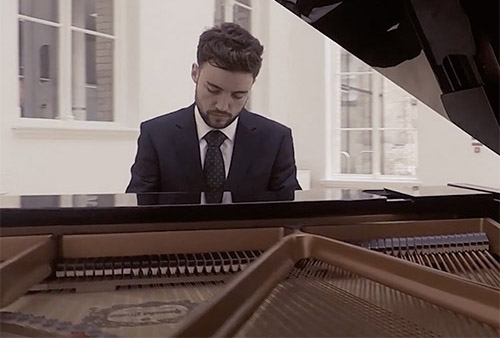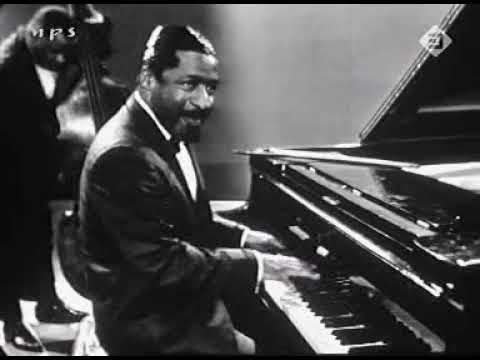
Hayden Hill
Hayden founded PianoGroove in 2015 with the goal of making the world a more musical place. He shares his love for jazz piano through his online courses and manages the community area of PianoGroove.
Live Seminar Resources
Live Seminar Resources
PDF Downloads
- Body & Soul Chord Chart
Join PianoGroove Pro to access all downloads and learning resources.
Download theory supplements, midi files, chord changes and full note-for-note transcriptions of every lesson.
- Beegie Adair Introduction Transcription
Join PianoGroove Pro to access all downloads and learning resources.
Download theory supplements, midi files, chord changes and full note-for-note transcriptions of every lesson.
Related Lessons
Forum Threads
Seminar Description
Seminar Description
In this live seminar we take a deep dive into the tune “Body & Soul” and explore the different levels of arranging a jazz standard using simple to advanced arranging techniques.







Video popped up late. Who is the lady you mentioned we should listen too?
Hi Tom 👋🏻
I have just added the seminar chapters so it will be much easier to navigate the sections of the seminar.
I see Robert mentioned below, the pianist in which we are studying in this lesson is Beegie Adair.
It’s her introduction from this recording that we are studying in this lesson: pianogroove.com/community/t/what-record-are-you-listening-to-today/37/760
Definitely check out her recordings on YouTube and Spotify etc…
She ha an extensive discography and has covered most of the jazz standards we explore on PianoGroove and I find her work to be a great source of inspiration.
Cheers,
Hayden
Beegie Adair…so glad Hayden highlighted her here! beegieadair.com/
Thanks for sharing the link Robert – and I’m glad you enjoyed the session. I agree Beegie is a wonderful pianist and it was a pleasure to cover her style in this seminar.
I have just added the seminar chapters so you can revisit each section of the seminar.
I will also write out her introduction in notation software and add as a PDF download for those interested in the transcription.
Cheers,
Hayden
Hayden,
thank you for the seminar yesterday for the song ‘Body & Soul’.
I understand the technical issues encountered in the live seminar and the virtual piano synchronisation towards the end.
Would be great if possible to sort that? In particular when you play the song itself and the Beegie Adair elements covered.
Also, is it possible to get transcriptions of any of her work?
Much appreciated
Adrian.
Hi Adrian,
My pleasure and glad you enjoyed the session.
My apologies for the technical issue, it was just the last 10 minutes of the seminar which I have removed from the archived version. I will make sure this doesn’t happen again.
I added the seminar chapters so you will now be able to navigate between the different sections where I cover the song itself and Beegie’s elements.
I have also added a PDF download “Beegie Adair Introduction Transcription” where I have notated her introduction and included the voicing names and exact chord colours and tensions. You can find this in the downloads section in the bottom right hand cover of this page.
For myself, the most interesting part is her use of Suspended chords for the VI7 chord, Bb7, I explain this in more detail in the chapter “Beegie Adair’s Sus Voicings” and of course please reference the PDF file for the exact voicings that I play.
Let me know if I can help further and enjoy playing around with this stuff.
Cheers,
Hayden
Hi Hayden,
Thank you for your reply.
The notated intro of Beegie for ‘Body & Soul’ is great to have and I look forward to working on it.
Cheers
Adrian.
Awesome, I’m glad it’s helpful Adrian.
She plays some beautiful voicings. It’s always a nice exercise to try to transpose things like this. Perhaps try to transpose the same voicings into the key of Eb Major, and you could use it as an introduction to set up a tune in Eb Major that starts on the ii-7 chord, for example, “I Fall In Love Too Easily” would be a good example:
pianogroove.com/jazz-piano-lessons/fall-in-love-to-easily-tutorial/
The same progression in the key of Eb Major would be A-11b5, D13b9, G-7b5, C13sus –> C7#5, F-9, Bb7#5#9, Ebmaj13, C13sus –> C7#5b9 which then moves to F-7 to start the tune.
The core benefit is from playing the same melodic figures that Beegie plays in her introduction, and transposing them around other keys. We then absorb little melodic phrases and motifs that become part of our ‘bag of inspiration’ when improvising or playing freely with a chord progression.
Then repeat this exact process with something else that you like the sound of.
Have fun playing with this stuff!
Cheers,
Hayden
It seems like the end of seminar got cut off at 44:15. Was there much more?
Hi Wendy 👋🏻
Yes there was a heat wave here on the day of the stream and my laptop over heated. Due to this the keyboard on the remaining 10 mins of the seminar was out of sync so it made sense to cut it off as the audio and microphone do not correlate to the visual.
Apologies for this…. I will find some kind of cooling mechanism for my next live stream in case of another heat wave.
I had covered everything that I wanted to cover and so the last 10 mins was just a recap.
I hope you still enjoyed the session and July seminar topics coming shortly.
Cheers,
Hayden
I believe there is a misprint of the B flat sus chord on your introduction. You doubled the B flat in your left hand rather than indicating an A flat which you played on the video. Thanks
Hi Edwin 👋🏻
Thanks for letting me know about this.
I have corrected the PDF file and updated the file in the seminar downloads, and also in the forum post.
I also removed the unnecessary accidentals which are already indicated by the key signature. The settings in my notation software add “cautionary accidentals” which I have now removed.
Remember to listen to Beegie’s actual introduction to absorb some her phrasing and other subtleties in how she voices the chords and adds her fills and ornamentations.
Thanks again for letting me know about the mis-spelt voicings. I will be adding July’s seminars to the site shortly and I will be hosting another similar session to this where we deep dive into a jazz standard.
Cheers,
Hayden
You played the rootless dominant B flat starting on the five of the chord rather than the 3d or 7th. Are there other rootless chords you would consider that? I have not seen anything written using other than type A and B forms. Thanks
Hi Edwin,
Yes I think you are talking about the dominant b9 / diminished voicing F-Ab-B-D which functions as a rootless Bb7b9.
Play those 4 notes in the right and play the Bb in your left hand to have Bb7b9.
Next keep those exact same notes in the right hand, but play an E in the left hand (tritone of Bb) and this gives us E7b9.
Those 4 notes in the right hand can also function as a rootless Db7b9, and a G7b9.
Simply keep the notes the same in the right hand, and switch between the notes Bb, Db, E, & G in the left hand. Those 4 notes also create a diminished chord themselves.
You might like to check out this theory lesson and the jazz standards in this course for more information: pianogroove.com/jazz-piano-lessons/understanding-diminished-chords/
and full course here: pianogroove.com/jazz-piano-lessons/diminished-chords-scales/
Cheers,
Hayden
Great seminar Hayden. I watched about 30 minutes and had to leave for an appointment. When I came back I found I couldn’t fast forward to where I’d left off (the bit where you’re going into “stride” in detail. I love listening to Beegie Adair and would love to be more competent in stride, but I find when I use the whole piano I often get “lost” coming home to the middle.
Hi George 👋
Glad you enjoyed the seminar and apologies for the late reply here.
For the stride section, check out the chapters starting at 26:25 and 30:51 – it’s around 31 minutes where I show the stride left hand exercise.
And yes I can related to the “lost feeling” in the centre of the piano. The most important thing for me is to be able to visualise the rootless shapes, often I look for the bottom note of the rootless voicing as my point of reference and then the rest of the voicing just slots on top.
We do have 2 practice exercises/drills here which you should find useful for improving this:
pianogroove.com/jazz-piano-lessons/rootless-voicings-stride-drill/
pianogroove.com/jazz-piano-lessons/251-stride-drill-with-rootless-voicings/
The other aspect is learning the form so that you don’t need to think about what is coming next and so that the left hand is on “auto-pilot”. I mention this in the seminar. Try having a conversation whilst playing the left hand stride, and once you can do that you will have complete freedom in your right hand. This “musical multi-tasking” is easier said than done but with practice it becomes easier and easier.
Hope that helps George!
Cheers,
Hayden